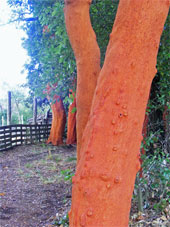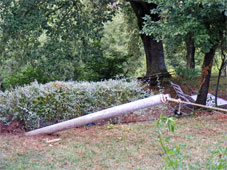CdP
7 October 2010
Pictures from a
summer without words
The Felicia roses outside the front door are blooming wildly again, and have sailed through the attack of leaf-stripping caterpillars which defaced so many other roses in our district – I’ve never had to deal with that problem before. The pale yellow R. Primo Passo hasn’t done so well on the bug front, but they’re still full of blooms which don’t, happily, seem to appeal to the caterpillars. In the vegetable garden, the runner beans have gone crazy as always, suddenly producing all the vast quantities of pods that they didn’t bother to produce in summer: you have to be careful not to give up on them before their finest hour.
The honeysuckle is blooming subtly. There’s still the odd flower on the hollyhocks, there are strawberries and raspberries every day. And the long bed in front of the kitchen is one big weed patch, with unwanted plants thriving nicely. I never seem to be able to finish that: I weed a strip then get side-lined, and don’t get back until the whole thing has slipped into uniform chaos and I’m starting over from square one. So much to do.
These lovely days are how I’d like the whole winter to be. Of course, it can rain from time to time – that’s what winter’s all about. But please please please let’s not have winters like the past two, where even stepping outside was painfully depressing. I want to spend my winter outside in bracing sunlight, doing things – doing all the many things that I’m sure I won’t get around to in the next couple of weeks when they should really be done, and doing things like constructing pergole and making proper lawns.
Priority number one, with all the water that falls in the amazingly tropical downpours we’re having from time to time at the moment is fixing up the lawns, and the rain channels in them in particular. All my drainage-care for our steeply sloping lawns seems to be going by the board: rain goes where it wants, and where it wants often involves washing soil out of my flower beds too. The grooves I created in lawns so long ago – narrow cross-ones, leading to more heavy-duty main ones – have either clogged up or become wide and wiggly undisciplined stream-beds with rocks emerging to send the channels of water every which way. These need to be straightened and smoothed and redirected. This should be done in conjunction with mowing (the grass is so long with all this damp and heat) and scarifying and fertilising. When will I find time?
Similarly, so much needs to be done in my orto. A few weeks ago I ripped up the hopeless mouldy courgettes along one side of a bed and piled lots of my sumptuous compost in there, then planted the tiny fennel I had grown in root trainers, and sowed a second row of fennel seeds. Never thinking, stupidly, that the compost was an insect-binge-extravaganza for all the district’s bird population. My fennel plants were buried and my seeds dispersed. I managed to dig out and straighten the foliage of most of the former, and now the latter are springing up but they’re nowhere near where I planted them. Hey ho. I emptied some other beds yesterday and filled them with compost and left them for the birds to do their thing. When I finally get around to planting them, I shall protect everything with fleece. I love vegetable gardens bulging with produce through the winter.
By next summer, I’d love to have the kitchen pergola, the bedroom terrace pergola and the orchard pergola in place. Ha.




Fruit trees – or apples at least – should be in my DNA, with all the pioneering Irish fruit-growers in my family tree. But somehow my frutteto is less than impressive. Of course, my ministrations there, as elsewhere, have always been haphazard. What’s more, I’m kind of weak-willed about pruning, justifying my lack of decisiveness by telling myself that I’m working on aesthetic rather than pared-back productive principles. But it would be nice to have a little more, less gnawed-on fruit. This year my limoncella apple was one big ant-and-aphid home. The little rennetta (pippin) produced a few rather fine apples, now partly in my green tomato chutney and partly chopped and frozen… but we’re talking two apple pies’ worth, no more.
The trouble last winter and spring was that even if I had known what I was doing, treatment-wise, would I really have been able to do it? It’s pretty pointless trying to spray with organic substances in driving rain, and that’s all we had. Actually, come to think of it, the fruit I did get was in the main surprisingly un-wormy: can my yellow sticky cards and very occasional spraying really have had an effect?
I was discussing the problems of organic fruit growing a couple of weeks ago with the wonderful Isabella dalla Ragione whose father began the work of ‘arboreal archeology’ which she now continues in her indomitable way in her orchard near Città di Castello. Her trees are all central Italian varieties, in danger of extinction as apple production focusses on ever-fewer supermarket-approved types.
Isabella says she’s getting more and more reticent about spraying at all, for fear of killing all her beneficial insects along with her harmful ones. Her lovely trees are bursting with fruit and it all looks wondrously healthy. When I can work out where to put them, I want to bring over some of her long-lost species and plant them here – the muso di bue with its beautifully elegant pear-shaped fruit and the rusty, rough roggia which I crunched my way through as I walked through the orchard. Just too lovely. She also said she was abandoning winter pruning for summer pruning, which allows you to lop out the wood-bearing as opposed to the fruit-bearing limbs more effectively. Too late for me to try that this year. But I’ll bear it in mind for next… as well as trying to be braver in my end-of-winter clean-out. My poor little trees: if I don’t take matters in hand, I’ll kill them with my kindness, leaving them to suffocate in criss-crossing branches and foliage.

